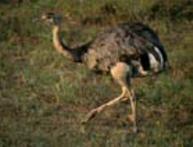

Common Names: Ñandú,
Greater Rhea, Gray Rhea, Common Rhea
Genus: Rhea
Species: americana

The Greater Rhea lives on the pampas, and open woodlands in the south-eastern part of South America. Although they live in the grasslands, they avoid open places and prefers areas with some tall vegetation. It prefers areas with tall vegetation near swamps or rivers.
It has powerful legs, each ending in three toes. Rheas can't fly and rely on their legs to outrun predators. Their long legs also help them spot predators over the tall grass of the pampas. They can also suddenly disappear in the tall grass by lying flat on the ground, with their heads straight out in front of them. They have very keen eyesight and hearing, and will jump and kick to protect itself and its chicks.
In spite of being unable to fly, they have very long wings. Rheas use their wings like rudders when they run to help them evade enemies. The Greater Rhea has grey and brown plumage with a little white and black sprinkled in it. They have feathers on their necks, but don't have any tail feathers.
The Greater Rhea belongs to a group of birds known as ratites. The African ostrich, the cassowary and emu from Australia and kiwis from New Zealand all belong to this group. These land masses were all once one giant continent called Gondwanaland.
Greater Rheas stand about 5 feet tall (1.5 meters) and are about half the height of an ostrich. They weigh about 50 pounds (20 to 25 kg). At six months the young rheas are almost as big as their parents. The male rhea is slightly larger than the female.
Greater Rheas are omnivorous, but prefer broad-leaved plants and clover as well as several kinds of seeds, roots and fruit. They also eat insects and small animals like lizards, frogs, small birds and snakes. As they feed they are constantly on the move.
The breeding season for the Greater Rhea is from August to January. Like the ostrich, the male rhea, will court two to twelve females. The males build a nest formed from a shallow hole in the ground surrounded by twigs and other vegetation. Each of the females will lay one egg in his nest at intervals about two days apart, and then move off to the next male to lay some more eggs.
The male rhea stays close to the nest until he has about ten to sixty eggs. These are cream-colored and weigh about 600 grams. After incubating the eggs for about six weeks, the chicks hatch and are raised by the male until they are 6 months old. The young rhea reach sexual maturity in 2 to 3 years.
In the spring the male Greater Rhea stay by themselves while the females form small flocks Yearling rheas stay with the female flock until until they are two years old. At the end of the summer, male, female, and yearling rheas all come together to form large flocks.
The population of Greater Rhea has gone down significantly and are considered as near threatened, although permits are now needed to export them. Their feathers are used to make feather dusters, while their skins are made into leather. Both their eggs and meat are eaten. Considered as pests because they will eat almost any crop, they are killed by farmers. As more of the pampas is turned into farmland, more rheas are killed.
2002
Bibliography:
Maija Schommer, "Rhea americana (Common Rhea, Gray Rhea): Narrative", http://animaldiversity.ummz.umich.edu/accounts/rhea/r._american a$narrative.html, (Oct 2001).
"Greater Rhea (Rhea americana), http://www.arthurgrosset.com/sabirds/greater%20rhea.html, (Oct 2001).
Suzanne ter Huurne, "Common Rhea", http://www.dierinbeeld.nl/animal_files/birds/common_rhea/index.html, (Oct 2001).